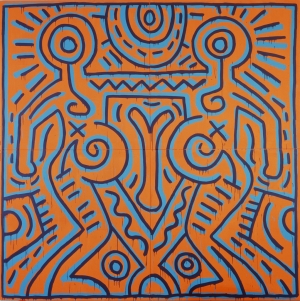
Photo by Timothy Greenfield-Sanders
Keith Haring
Artist Bio
In his short but prolific career, Keith Haring was known for his fluid, uniform lines, intricate compositions, and repeating imagery such as the barking dog and radiant baby. Since the 1980s, Haring’s art has garnered worldwide recognition, breaking down barriers and spreading joy while shining a bright light on complex issues from capitalism and the proliferation of new technologies to sexuality and race.
Born in 1958, Keith Haring grew up in Kutztown, Pennsylvania, where his father, Allen, taught him to draw cartoons from Walt Disney and Dr. Seuss. He moved to New York City in 1978 to enroll in the School of Visual Arts (SVA). In New York, he embraced his homosexuality, which informed his worldview and art practice. The city was pulsing with energy with the emergence of hip-hop, graffiti art, and an active nightclub scene. In alternative spaces such as Club 57 and Paradise Garage, Haring developed his visual style alongside artists Kenny Scharf and Jean-Michel Basquiat, performers Grace Jones and Madonna, and many others.
Haring pushed boundaries, creating outside of traditional art spaces. He made chalk drawings in New York subway stations and murals all over the world, worked with youth, frequently collaborated across disciplines, and took on commercial projects. Haring’s public works were often made illicitly, and dynamic immediacy is a hallmark of his style. At the same time, Haring gained international attention from collectors, showing his art in galleries and museums.
Haring’s activism was central to his practice. He used his imagery and celebrity to protest apartheid in South Africa, raise awareness of the crack cocaine epidemic and the AIDS crisis, and support causes from nuclear disarmament to UNICEF. In February 1990, Haring died of AIDS-related complications at the age of thirty-one. In his short but prolific career, Haring produced a remarkable volume of work guided by the unflinching belief that art is essential in making a better world.







